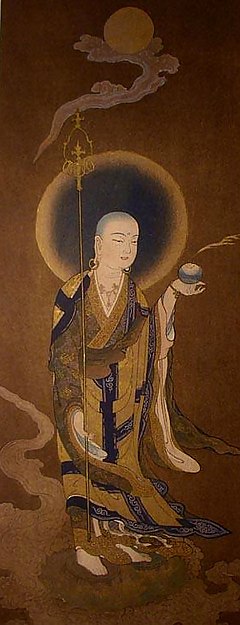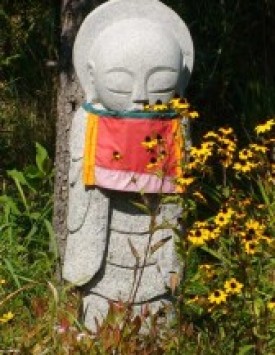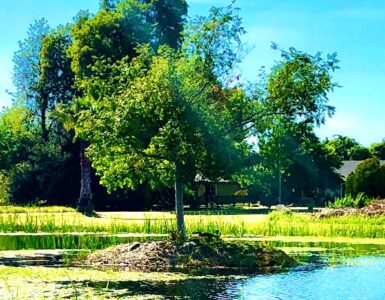
Ksitigarbha, the earth store bodhisattva, with his staff he uses to pound open the gates of Hell, and his cintamani pearl for illuminating all the various realms of hell, to benefit sentient beings trapped there.
Chinese: 地藏菩薩 Dìzàng Púsà; Japanese: Jizō; Korean: 지장; Vietnamese: Địa Tạng; Tibetan: ས་ཡི་སྙིང་པོ Sayi Nyingpo] is a bodhisattva primarily revered in East Asian Buddhism and usually depicted as a Buddhist monk. Kṣitigarbha is one of the Eight Great Bodhisattvas in Mahāyāna Buddhism, along with Mañjuśrī, Samantabhadra, Mahāsthāmaprāpta (Vajrapani), Akasagarbha, Avalokiteśvara, Maitreya and Sarvanivarana-Vishkambhin. His name may be translated as “Earth Treasury”, “Earth Store”, “Earth Matrix”, or “Earth Womb”. Kṣitigarbha is known for his vow to take responsibility for the instruction of all beings in the six worlds between the death of Gautama Buddha and the rise of Maitreya, as well as his vow not to achieve Buddhahood until all hells are emptied. He is therefore often regarded as the bodhisattva of hell-beings, as well as the guardian of children and patron deity of deceased children and aborted fetuses in Japanese temples shown below.
Ksitigarbha (Di Zang Pu-sa) was the enlightened monk who vowed to go to Hell and work there to liberate hell beings. He vowed he would not become a Buddha until all of the hells are empty. The Ksitigarbha Dharma Assembly, held every year on or before Ksitigarbha’s birthday, is the time when Buddhists go to their temples to pray for deceased family members and friends and ask for special blessings for themselves and others. They also make offerings to their temples to have the rinpoches, lamas, monks, and nuns perform certain rituals that will help those suffering in lower migrations (as hell beings, hungry ghosts, animals, or unfortunate humans) be raised to a higher level of consciousness and gain liberation or enlightenment. Ksitigarbha Bodhisattva’s birthday is celebrated on or near the thirtieth day of the seventh lunar month each year.

Traditionally, he is seen as the guardian of children, particularly children who died before their parents. Since the 1980s, the tendency developed in which he was worshipped as the guardian of the souls of mizuko, the souls of stillborn, miscarried or aborted fetuses. In Japanese mythology, it is said that the souls of children who die before their parents are unable to cross the mythical Sanzu River on their way to the afterlife because they have not had the chance to accumulate enough good deeds and because they have made their parents suffer. It is believed that Jizō saves these souls. Jizō statues are sometimes accompanied by a little pile of stones and pebbles, put there by people in the hope that it would shorten the time children have to suffer in the underworld (the act is derived from the tradition of building stupas as an act of merit-making). The statues can sometimes be seen wearing tiny children’s clothing or red bibs, or with toys, put there by grieving parents to help their lost ones and hoping that Jizō would specially protect them. Sometimes the offerings are put there by parents to thank Jizō for saving their children from a serious illness. Jizō’s features are also commonly made more babylike in order to resemble the children he protects.

CLICK for article on Dharma for the unborn baby.
In Japan, Kṣitigarbha is known as Jizō or Ojizō-sama as he is respectfully known and is one of the most loved of all Japanese divinities. His statues are a common sight, especially by roadsides and in graveyards.
As he is seen as the saviour of souls who have to suffer in the underworld, his statues are common in cemeteries. He is also believed to be the protective deity of travellers, and roadside statues of Jizō are a common sight in Japan. Firefighters are also believed to be under the protection of Jizō. The six Jizo Bodhisattvas shown below are from the Gedatsu Temple in Sacramento, California representing the form Ksitigarbha Bodhisattva takes to help liberate beings from all six realms of existence.

Kshitigarbha Bhodisattva is considered to be an incarnation of one of Shakyamuni Buddha’s closest disciples, Maudgalyayana (Pali: Moggallana), the blue-skinned Arhat who was foremost in supernatural powers and whose story is told in the Ullambana Sutra.
CLICK for link on article on Ksitigarbha Bodhisattva Dharma Assembly held at Hua Zang Si in San Francisco, California on September 1, 2024.





Add comment